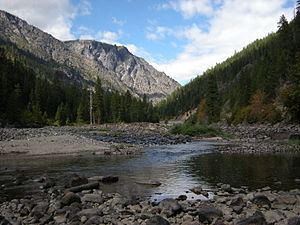- min 221 cu ft/s (6 m/s) Length 85 km Basin 1,333 sq mi (3,452 km2) | - average 3,231 cu ft/s (91 m/s) Discharge 91.49 m³/s Basin area 3,452 km² | |
 | ||
- max 45,200 cu ft/s (1,280 m/s) Cities Wenatchee, Leavenworth, Cashmere | ||
Wenatchee river rafting with creature craft class 5 6 white water in tumwater canyon
The Wenatchee River is a river in the U.S. state of Washington, originating at Lake Wenatchee and flowing southeast for 53 miles (85 km), emptying into the Columbia River immediately north of Wenatchee, Washington. On its way it passes the towns of Plain, Leavenworth, Peshastin, Dryden, Cashmere, Monitor, and Wenatchee, all within Chelan County.
Contents
- Wenatchee river rafting with creature craft class 5 6 white water in tumwater canyon
- Map of Wenatchee River Washington USA
- Leavenworth washington whitewater kayaking tumwater canyon on the wenatchee river
- HistoryEdit
- PollutionEdit
- References
Map of Wenatchee River, Washington, USA
Tributaries include the Chiwawa River, Nason Creek, Peshastin Creek, and Icicle Creek. Its drainage basin is 1,333 square miles (3,450 km2) in area.
Leavenworth washington whitewater kayaking tumwater canyon on the wenatchee river
HistoryEdit
Historically the dividing line between Okanogan County and Kittitas County, the river has been in the center of Chelan County since the county's formation around 1899.
Water from the Wenatchee River and its tributaries has been diverted for irrigation since 1891, mainly for orchards. There are two small dams on the Wenatchee River, the Tumwater Canyon Dam, which sits just west of the community of Leavenworth, and the Dryden dam, a low-head dam situated just outside the town of Dryden. The Tumwater Canyon dam originally provided power to the original 2-mile (3.2 km)-long railroad tunnel used near Stevens Pass to get trains across the Cascade Mountains, it was later (starting in 1928) used to power the railroad's electrification from Wenatchee to Skykomish.
PollutionEdit
Toxic chemicals banned decades ago in Washington continue to linger in the environment and concentrate in the food chain, threatening people and the environment, according to three recent studies by the Washington state Department of Ecology. In 2007, the Washington Department of Health advised the public to not eat mountain whitefish from the Wenatchee River from Leavenworth downstream to where the river joins the Columbia, due to unhealthy levels of PCBs.
